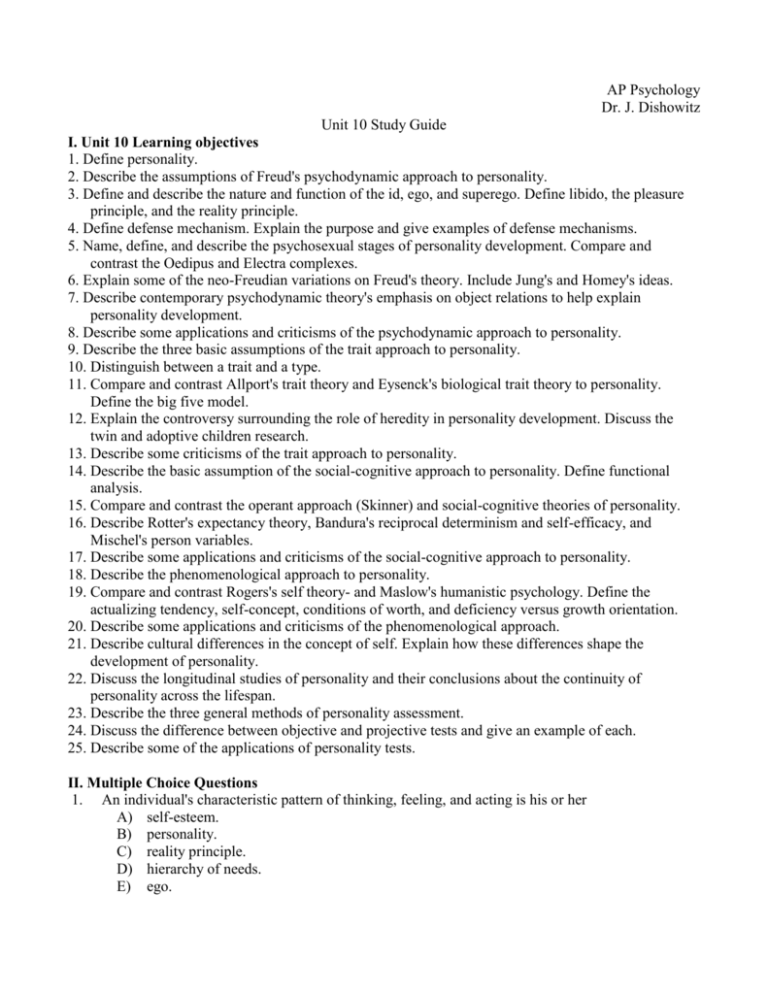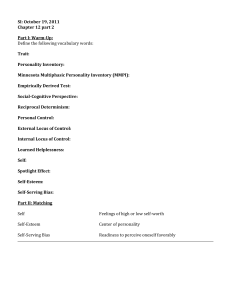Unit 10 Study Guide
advertisement

AP Psychology Dr. J. Dishowitz Unit 10 Study Guide I. Unit 10 Learning objectives 1. Define personality. 2. Describe the assumptions of Freud's psychodynamic approach to personality. 3. Define and describe the nature and function of the id, ego, and superego. Define libido, the pleasure principle, and the reality principle. 4. Define defense mechanism. Explain the purpose and give examples of defense mechanisms. 5. Name, define, and describe the psychosexual stages of personality development. Compare and contrast the Oedipus and Electra complexes. 6. Explain some of the neo-Freudian variations on Freud's theory. Include Jung's and Homey's ideas. 7. Describe contemporary psychodynamic theory's emphasis on object relations to help explain personality development. 8. Describe some applications and criticisms of the psychodynamic approach to personality. 9. Describe the three basic assumptions of the trait approach to personality. 10. Distinguish between a trait and a type. 11. Compare and contrast Allport's trait theory and Eysenck's biological trait theory to personality. Define the big five model. 12. Explain the controversy surrounding the role of heredity in personality development. Discuss the twin and adoptive children research. 13. Describe some criticisms of the trait approach to personality. 14. Describe the basic assumption of the social-cognitive approach to personality. Define functional analysis. 15. Compare and contrast the operant approach (Skinner) and social-cognitive theories of personality. 16. Describe Rotter's expectancy theory, Bandura's reciprocal determinism and self-efficacy, and Mischel's person variables. 17. Describe some applications and criticisms of the social-cognitive approach to personality. 18. Describe the phenomenological approach to personality. 19. Compare and contrast Rogers's self theory- and Maslow's humanistic psychology. Define the actualizing tendency, self-concept, conditions of worth, and deficiency versus growth orientation. 20. Describe some applications and criticisms of the phenomenological approach. 21. Describe cultural differences in the concept of self. Explain how these differences shape the development of personality. 22. Discuss the longitudinal studies of personality and their conclusions about the continuity of personality across the lifespan. 23. Describe the three general methods of personality assessment. 24. Discuss the difference between objective and projective tests and give an example of each. 25. Describe some of the applications of personality tests. II. Multiple Choice Questions 1. An individual's characteristic pattern of thinking, feeling, and acting is his or her A) self-esteem. B) personality. C) reality principle. D) hierarchy of needs. E) ego. 2. Freud became interested in unconscious personality dynamics when he noticed that certain patients' symptoms A) resulted from the physical abuse they received from their parents during childhood. B) reflected an internal locus of control. C) illustrated a reciprocal determinism. D) made no neurological sense. E) were passed down genetically. 3. Prior to his use of free association, Freud had encouraged patients to retrieve their forgotten memories by means of A) hypnosis. B) projective tests. C) psychoactive drugs. D) fixation. E) personality inventories. 4. In suggesting that the mind is mostly hidden, Freud was most clearly emphasizing the importance of the A) inferiority complex. B) instincts. C) unconscious. D) psychosexual stages. E) internal locus of control. 5. According to Freud, thoughts that are too unsettling for people to acknowledge are A) manifest contents. B) self-serving biases. C) repressed. D) inferiority complexes. E) social-cognitive. 6. Ego is to id as ________ is to ________. A) unconscious; conscious B) biology; morality C) reality principle; pleasure principle D) regression; repression E) external locus of control; internal locus of control 7. Bruce wants to be a loving husband but at the same time wants to express his disgust for some of his wife's habits. According to Freud, Bruce's ________ might enable him to partially satisfy both desires. A) self-transcendence B) superego C) Oedipus complex D) ego E) id Page 2 8. Freud believed that personality forms as children A) seek fulfillment in a hierarchy of physical and psychological needs. B) demonstrate personality factors on five main dimensions. C) pass through a series of psychosexual stages. D) experience the reciprocal forces of internal and external forces. E) conquer feelings of inferiority and anxiety. 9. Four-year-old John is very competitive with his father in trying to gain more attention from his mother. Freud would have suggested that John is going through the ________ stage of development. A) phallic B) latency C) anal D) oral E) displacement 10. One night after he heard his parents arguing, 4-year-old Wei had a vivid dream in which he saved his mother from being bitten by a large snake. A psychoanalyst would most likely suspect that Wei's dream reflects a(n) A) oral fixation. B) reaction formation. C) self-serving bias. D) Oedipus complex. E) external locus of control. 11. Freud suggested that slips of the tongue illustrate an incomplete A) fixation. B) displacement. C) rationalization. D) projection. E) repression. 12. Freud would have suggested that an excessive fixation is most likely to contribute to A) reaction formation. B) regression. C) learned helplessness. D) an Electra complex. E) self-serving bias. 13. Abdul mistakenly believes that his classmates are unusually hostile. In fact, Abdul is the most quarrelsome and aggressive child in the school. According to psychoanalytic theory, Abdul's belief that his classmates are hostile is a A) regression. B) projection. C) denial. D) reaction formation. E) repression. 14. The defense mechanism in which self-justifying explanations replace the real, unconscious reasons for actions is A) projection. B) denial. C) rationalization. D) displacement. E) reaction formation. Page 3 15. Alfred Adler was a neo-Freudian who coined the term A) oral fixation. B) reciprocal determinism. C) inferiority complex. D) unconditional positive regard. E) unconscious. 16. Neo-Freudian personality theorists were most likely to disagree with Freud about the importance of A) the unconscious dynamics underlying behavior. B) childhood sexual instincts. C) anxiety and defense mechanisms. D) distinguishing between id, ego, and superego. E) unconscious impulses and anxieties. 17. Of the following, who would be most interested in the fact that many cultures share stories containing a “hero” character, such as King Arthur of Great Britain, Quetzlcoatl of the Aztecs, and Hercules of the ancient Greeks? A) Sigmund Freud B) Alfred Adler C) Karen Horney D) Carl Jung E) Erik Erikson 18. Carl Jung emphasized the importance of ________ in personality functioning. A) social interest B) inferiority feelings C) psychosexual stages D) the collective unconscious E) unconditional positive regard 19. Mr. Dutoit was asked by his psychotherapist to look at some ambiguous pictures and make up a story about each. Mr. Dutoit was most likely taking the A) TAT. B) Myers-Briggs Type Indicator. C) MMPI. D) Rorschach test. E) Eysenck Personality Questionnaire. 20. The famous test introduced by Hermann Rorschach asks test-takers to respond to A) frightening pictures. B) ambiguous stories. C) meaningless inkblots. D) incomplete sentences. E) objective questions. 21. Survivors' vivid memories of Nazi death camp experiences most clearly challenge Freud's concept of A) fixation. B) repression. C) the Oedipus complex. D) motivational conflict. E) projection. Page 4 22. The humanistic perspective emphasized the importance of A) the self-reference phenomenon. B) self-determination. C) reciprocal determinism. D) factor analysis. E) free association. 23. According to Maslow, the desire to fulfill one's potential is the motivation for A) personal control. B) self-actualization. C) self-esteem. D) unconditional positive regard. E) reciprocal determinism. 24. Carl Rogers referred to an attitude of total acceptance toward another person as A) the spotlight effect. B) unconditional positive regard. C) self-actualization. D) free association. E) self-esteem needs. 25. Sigmund Freud explained personality in terms of unconscious motivations, whereas ________ described personality in terms of enduring traits. A) Gordon Allport B) Carl Rogers C) Albert Bandura D) Hermann Rorschach E) Karen Horney 26. Factor analysis has been used to identify the most basic A) self-serving biases. B) defense mechanisms. C) personality traits. D) psychosexual stages. E) self-concepts. 27. Martin is optimistic, impulsive, excitable, and restless. In terms of the Eysencks' basic personality dimensions, he would be classified as A) external–dependent. B) manic–depressive. C) unstable–extraverted. D) passive–aggressive. E) internal–mesomorphic. 28. The MMPI is an example of a(n) A) projective test. B) personality inventory. C) inkblot test. D) self-esteem test. E) humanistic test. Page 5 29. The Big Five is the term currently used to refer to basic A) psychosexual stages. B) defense mechanisms. C) trait dimensions. D) sensory modalities. E) reaction formations. 30. The humanistic perspective is to Abraham Maslow as the social-cognitive perspective is to A) Gordon Allport. B) Carl Rogers. C) Alfred Adler. D) Albert Bandura. E) Carl Jung. 31. Because Greta is an extravert, she frequently goes to parties where she is encouraged to laugh and socialize with her friends. Because Jim is an introvert, he frequently spends weekends in the library where it's easy to quietly reflect and study. Greta and Jim best illustrate what is meant by A) an external locus of control. B) reciprocal determinism. C) the self-reference phenomenon. D) the Barnum effect. E) reaction formation. 32. Emma believes that she will succeed in business if she works hard and carefully manages her time. Her belief most clearly illustrates A) reaction formation. B) reciprocal determinism. C) unconditional positive regard. D) the self-reference phenomenon. E) an internal locus of control. 33. Learned helplessness is MOST likely to be associated with A) self-serving bias. B) an external locus of control. C) the false consensus effect. D) unconditional positive regard. E) the spotlight effect. 34. Which of the following perspectives builds its personality theory from psychological research on learning and cognition? A) psychodynamic B) humanistic C) trait D) social-cognitive E) neo-Freudian 35. Athletes often attribute their losses to bad officiating. This best illustrates A) an Electra complex. B) learned helplessness. C) the spotlight effect. D) self-serving bias. E) the Barnum effect. Page 6 36. Psychologist Jean Twenge refers to today's new generation as Generation Me because it expresses more A) openness. B) narcissism. C) free association. D) unconditional positive regard. E) self-concept. 37. A willingness to switch jobs and move from one part of the country to another best illustrates one of the consequences of A) collectivism. B) sublimation. C) individualism. D) spotlight effect. E) self-actualization. 38. Compared with those in cultures that value individualism, people in collectivist cultures are especially likely to value personal A) modesty. B) privacy. C) freedom. D) achievements. E) autonomy. 39. Social roles are especially likely to be central to people's self-identity in ________ cultures. A) individualist B) ethnically diverse C) collectivist D) racially diverse E) democratic 40. Rachel is driven to attain her personal goal of being the top student in her AP psychology class. Rachel was most likely brought up in a ___________ culture. A) collectivist B) empathic C) individualistic D) diverse E) positive Page 7








